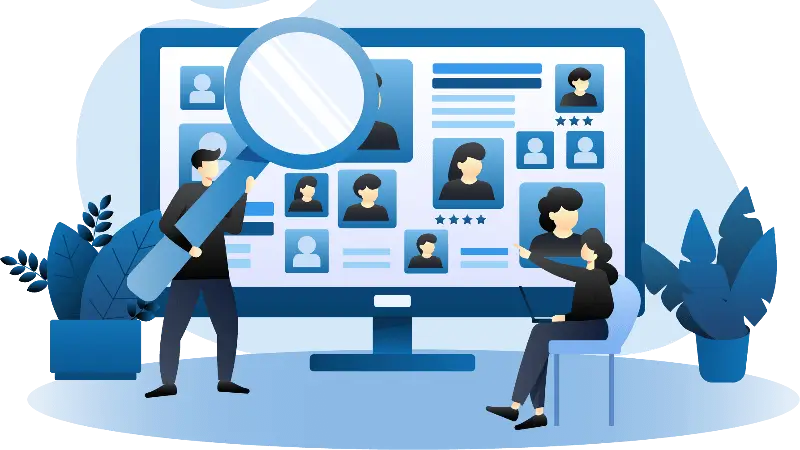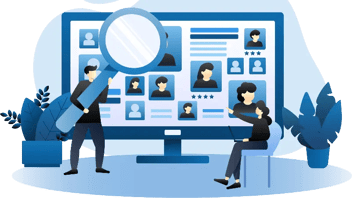Buyer Personas vs. Ideal Customer Profiles: What's the Difference?
Have you ever crafted the perfect marketing campaign only to be met with silence? The problem might not be your message but who you're sending it to. Understanding your target audience is crucial for effective marketing.
We will differentiate buyer personas and ideal customer profiles–two powerful tools that can help you pinpoint your ideal customer and amplify your marketing success.
What is an Ideal Customer Profile (ICP)?
An ideal customer profile (ICP) is a detailed description of the perfect customer for your business. It's a way to identify the companies that are the best fit for your product or service and focus your marketing efforts accordingly.
An ICP includes key characteristics that help you identify and target the right businesses. These characteristics typically fall into three categories:
Demographics
These are the basic attributes of your ideal customer, such as:
-
Industry: Which industries are most likely to benefit from your product or service? (e.g., healthcare, technology, finance)
-
Company size: Are you targeting startups, small businesses, or large enterprises? (e.g., 1-10 employees, 50-250 employees, 1000+ employees)
-
Location: Where are your ideal customers located? (e.g., specific countries, regions, or cities)
Firmographics
These delve deeper into the financial and organizational structure of your ideal customer:
-
Revenue: What is their annual revenue range? (e.g., $1 million - $5 million, $10 million - $50 million)
-
Budget: How much are they likely to spend on your type of product or service?
-
Growth trajectory: Are they rapidly expanding, stable, or experiencing slow growth?
Psychographics
These explore the more intangible aspects of your ideal customer:
-
Goals: What are their primary business objectives? (e.g., increase efficiency, expand market share, improve customer satisfaction)
-
Challenges: What problems are they facing that your product or service can solve? (e.g., high operating costs, outdated technology, lack of skilled workers)
-
Values: What is important to them in a business partner? (e.g., innovation, reliability, sustainability)
Example:
Let's say you're a software company that provides project management tools. Your ICP might look something like this:
-
Industry: Technology, Marketing, and Advertising
-
Company size: 50-250 employees
-
Location: United States
-
Revenue: $5 million - $20 million
-
Goals: Improve team collaboration, streamline workflows, increase project success rates
-
Challenges: Difficulty managing multiple projects, lack of visibility into project progress, inefficient communication
By developing a clear ICP, you can:
-
Focus your marketing efforts: Concentrate on the companies that are most likely to become customers.
-
Improve your sales efficiency: By targeting the right companies, you can increase your conversion rates and shorten your sales cycle.
-
Develop more effective marketing campaigns: When you know who you're talking to, you can create more targeted and relevant messaging.
-
Align your sales and marketing teams: A shared understanding of the ICP ensures that everyone is working towards the same goals.
Creating an ICP is a crucial first step in developing a successful marketing strategy. It helps you lay the foundation for targeted, efficient, and effective marketing campaigns that drive results.
What is a Buyer Persona?
While an Ideal customer profile (ICP) paints a picture of the company, a buyer persona zooms in on the individuals within that company who make the purchasing decisions. It's a semi-fictional representation of your ideal customer based on research and data about your existing and potential customers.
Think of a buyer persona as a detailed character sketch. It goes beyond basic demographics to include their motivations, goals, and challenges. This in-depth understanding allows you to tailor your marketing messages and create content that truly resonates with your audience.
Here are some key elements that make up a Buyer Persona:
Personal Background:
-
Age: What is the age range of your typical buyer?
-
Gender: Is your product or service geared towards a specific gender?
-
Education: What is their level of education?
-
Occupation: What is their current job title and role within the company?
-
Location: Where do they live and work?
-
Family life: Are they single, married, with children?
-
Lifestyle: What are their interests and hobbies outside of work?
Professional Background:
-
Job title: What is their specific job title?
-
Responsibilities: What are their daily tasks and responsibilities?
-
Career goals: What are their aspirations for their career?
-
Challenges: What obstacles do they face in their work?
Values and Goals:
-
Personal values: What are their core values and beliefs?
-
Professional goals: What are they trying to achieve in their role?
-
Pain points: What are their biggest frustrations and challenges?
-
Motivations: What drives their decision-making?
Behavioral Patterns:
-
Information sources: Where do they go to find information? (e.g., industry publications, websites, social media)
-
Content consumption: What type of content do they prefer? (e.g., blog posts, videos, infographics)
-
Social media usage: Which social media platforms do they use?
-
Purchasing behavior: How do they make purchasing decisions? (e.g., research online, consult with colleagues, attend industry events)
Example:
Let's say you're a marketing automation company. One of your buyer personas might be "Marketing Manager Mia."
-
Mia is a 32-year-old marketing manager at a mid-sized tech company.
-
She's responsible for lead generation and nurturing, email marketing, and social media.
-
She's ambitious and wants to advance her career by demonstrating strong marketing ROI.
-
She's frustrated with the limitations of her current marketing tools and is looking for a solution that can streamline her workflow and improve efficiency.
-
She's active on LinkedIn and Twitter, where she stays up-to-date on the latest marketing trends.
By creating detailed buyer personas like "Marketing Manager Mia," you can:
-
Personalize your marketing messages: Craft targeted content that speaks directly to the needs and pain points of your ideal customers.
-
Improve engagement: Increase engagement with your marketing campaigns by delivering relevant and valuable content.
-
Develop more effective marketing strategies: Understand how your target audience makes decisions and tailor your approach accordingly.
-
Enhance your product development: Gain insights into the needs and wants of your customers to inform your product roadmap.
Buyer personas are a powerful tool for any business looking to connect with their target audience on a deeper level. By understanding your customers' motivations, goals, and challenges, you can create marketing campaigns that resonate, engage, and drive results.
Key Differences Between Buyer Personas and ICPs
Now that we've explored ICPs and buyer personas individually, let's put them in the ring for a head-to-head comparison. While they both contribute to understanding your target audience, they have distinct differences that determine when and how you should use them.
Focus
The primary difference lies in their focus. ICPs focus on the company level, providing a macroscopic view of the ideal organization you want to do business with. They help you answer the question: "What type of company is the best fit for our product or service?"
Buyer personas, on the other hand, focus on the individual level, providing a microscopic view of the people within those companies who make the purchasing decisions. They help you answer the question: "Who are the specific individuals within these companies that we need to reach and influence?"
Scope
ICPs have a broader scope, encompassing a wider range of characteristics that define the ideal company, such as industry, company size, revenue, and organizational structure.
Buyer personas have a more specific scope, delving deeper into the individual's background, motivations, goals, and behaviors.
Purpose
ICPs serve a more strategic purpose, primarily used in the early stages of marketing to define your target market and guide your overall marketing strategy. They help you focus your efforts on the companies that are most likely to become customers.
Buyer personas serve a more tactical purpose, primarily used in the later stages of marketing to personalize messaging and tailor content to specific individuals within your target companies. They help you create marketing campaigns that resonate with your audience and drive engagement.
| Feature | Ideal Customer Profile (ICP) | Buyer Persona |
| Focus | Company | Individual |
| Scope | Broad | Specific |
| Purpose | Strategic | Tactical |
| Examples of Characteristics | Industry, company size, revenue | Job title, goals, challenges, behaviors |
Understanding the distinct roles of ICPs and buyer personas is crucial for developing a comprehensive marketing strategy. By using both tools effectively, you can ensure that you're targeting the right companies and the right people within those companies, maximizing your marketing ROI.
When to Use an ICP vs. Buyer Persona
ICPs and buyer personas play distinct roles in different stages of your marketing journey. Think of it as building a house: first, you need a solid foundation (ICP), and then you can focus on the interior design (buyer personas).
Early-Stage Marketing
In the initial stages of marketing, when you're still defining your target market and developing your overall strategy, ICPs are your go-to tool. They help you answer fundamental questions like:
-
Where should we focus our marketing efforts? ICPs help you identify the industries, company sizes, and locations that are most likely to benefit from your product or service. This allows you to segment the market and prioritize your outreach.
-
What channels should we use? Understanding your ICP's preferred communication channels (e.g., industry events, online publications, social media platforms) enables you to reach them where they're most active.
-
What messaging will resonate? By understanding your ICP's goals, challenges, and values, you can craft compelling messaging that speaks directly to their needs.
Later-Stage Marketing
Once you have a solid foundation with your ICP, you can start to build upon it with buyer personas. These come into play when you're ready to:
-
Create targeted content: Buyer personas provide deep insights into your ideal customer's interests, preferences, and content consumption habits. This allows you to create content that is relevant, engaging, and valuable to them.
-
Personalize your marketing campaigns: Leverage buyer personas to tailor your marketing messages and offers to specific individuals within your target companies. This increases the likelihood of conversion by delivering a personalized experience.
-
Improve customer engagement: By understanding your buyer personas' pain points and motivations, you can address their specific needs and provide solutions that resonate with them, fostering deeper engagement and loyalty.
Examples:
-
ICP: A SaaS company targeting healthcare providers might use their ICP to focus their marketing efforts on hospitals with over 200 beds, located in urban areas, and with a demonstrated interest in digital transformation.
-
Buyer persona: A marketing automation platform might create a buyer persona for "Marketing Manager Mark," who struggles with lead nurturing. They can then develop targeted content, such as a case study showcasing how their platform helped a similar company improve their lead nurturing process and deliver it through Mark's preferred channels, such as LinkedIn.
By strategically using ICPs and buyer personas at different stages of your marketing journey, you can create a powerful synchronization that drives targeted results and maximizes your marketing ROI.
Target the Right Audience, Every Time
Understanding the difference between buyer personas and ideal customer profiles is crucial for effective marketing. While ICPs help you target the right companies, buyer personas allow you to personalize your message for the individuals within those companies. By using both strategically, you can create marketing campaigns that resonate, engage, and drive results.
Ready to take your marketing to the next level? Contact Aspiration Marketing today! Our team of experts can help you develop detailed ICPs and buyer personas, as well as create targeted marketing strategies that deliver real results.
Let us help you connect with your ideal customers and achieve your marketing goals.
This content is also available in:
- German: Buyer Personas vs. Ideale Kundenprofile: Was ist der Unterschied?
- Spanish: Buyer Persona vs. Cliente Ideal: diferencias
- French: Personas et Clients Idéaux : La Différence pour un Marketing Efficace
- Italian: Buyer Personas vs. Profili del cliente ideale: Qual è la differenza?
- Romanian: Buyer Personas vs. Profilul clientului ideal: Care este diferența?
- Chinese: 买家角色与理想客户档案:有什么区别?










Leave a Comment